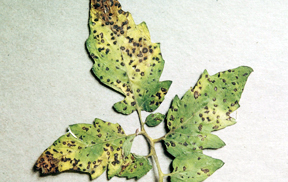Septoria leaf spot of tomatoes
Editor’s note: This article is from the archives of the MSU Crop Advisory Team
Alerts. Check the label of any pesticide referenced to ensure your use is
included.
We are
currently seeing quite a few tomato samples with Septoria leaf spot.
This is a fairly common disease on tomato, both on plants in home
gardens and in commercial fields.
Septoria leaf spot, which is caused by Septoria lycopersici, results in spotting and wilting of tomato foliage. Symptoms develop first on the lowest leaves of the plants.
This fungal disease causes circular spots with dark brown margins and
tan to gray centers dotted with black specks (pycnidia). A narrow yellow
halo is often associated with leaf lesions. If the leaf lesions are
numerous, some infected leaves turn slightly yellow and then brown, and
wither. Fruit infection is rare.
S. lycopersici overwinters on infected tomato debris or debris of
solanaceous weed hosts, such as horsenettle. The fungus can also survive
on equipment such as plant stakes and cages. Once introduced to a
planting area, conidia are spread by splashing water from rain or
sprinkler irrigation. Long periods of high relative humidity, high
temperatures, and leaf wetness are ideal conditions for disease
development and spread of the pathogen.
Tomatoes should be treated with registered protective fungicide sprays
at regular intervals during the growing season. There are several
fungicides available to home gardeners that are effective in preventing
fungal diseases of tomato. To be a prudent consumer you need to read the
fine print on the product label while you are shopping. First, the
product must be labeled for use on tomatoes. Second, look at the active
ingredient(s) listed on the label. Products that contain chlorothalonil
or ethylene bisdithiocarbamate (EBDC) will protect plants from
infection. Depending on the particular manufacturer the trade names
vary, these may be sold under trade names such as Daconil, Mancozeb, or
Fungonil, to name a few. Theses fungicides will need to be reapplied
frequently, usually a seven-day interval is recommended. Refer to the
product label for specific instructions.
In addition to fungicide sprays, cultural control measures include
rotating for at least one to two years between tomato crops, control of
susceptible weeds (such as horsenettle) in rotation crops, removal of
crop debris from the planting area, careful attention to the timing of
irrigation to reduce the length of time during which the plants remain
wet, and staking plants to improve air circulation and reduce contact
between foliage and soil.



 Print
Print Email
Email



